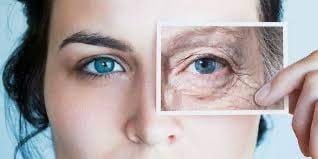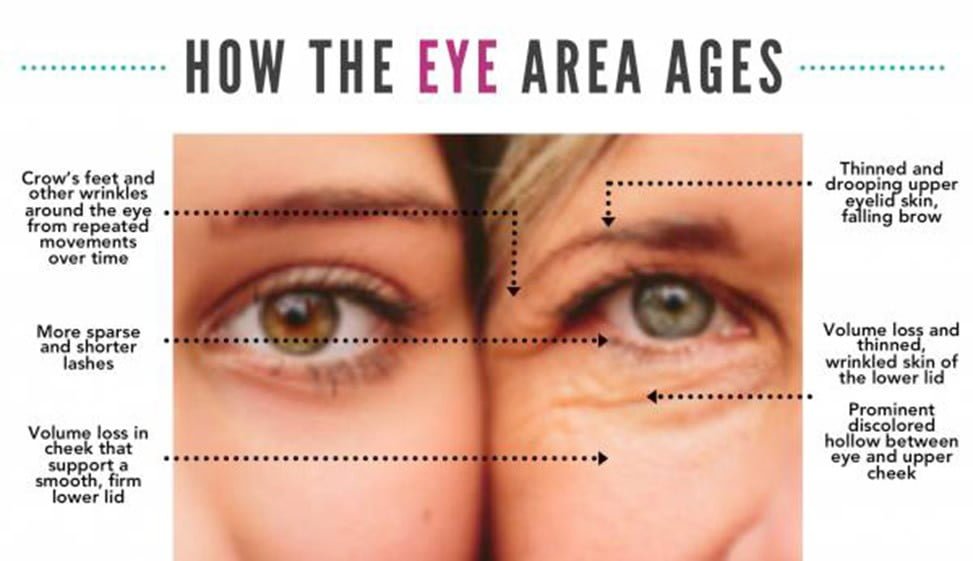 The eye area is one of the first areas of the face to show signs of ageing due to a variety of factors, including genetics, sun exposure, and lifestyle factors like smoking and poor nutrition. Here are some of the ways that the eye area can age:
The eye area is one of the first areas of the face to show signs of ageing due to a variety of factors, including genetics, sun exposure, and lifestyle factors like smoking and poor nutrition. Here are some of the ways that the eye area can age:
- Skin quality: As we age, the skin around the eyes can become thinner and lose elasticity, making it more prone to fine lines, wrinkles, and sagging. The delicate skin around the eyes is also more susceptible to UV radiation and environmental toxins damage.
- Laxity: Loss of skin elasticity can lead to sagging and drooping of the eyelids and brows, creating a tired or sad appearance. This is often due to a combination of collagen and elastin breakdown and the weakening of the muscles that support the eyelids.
- Bone loss: As we age, we also experience a loss of bone density, which can affect the orbital area around the eyes. Loss of bone can lead to a hollowing effect under the eyes, making dark circles and bags more pronounced.
All of these factors can contribute to an overall tired or aged appearance around the eyes and may be addressed with various treatments such as injectables, lasers, Botox, and surgery like blepharoplasty. Skincare can also play an important role in maintaining the health and appearance of the skin around the eyes
The Skin and Eye Area:
The skin under the eye is thinner and more delicate than the skin on the rest of the face, which makes it more susceptible to damage and visible signs of ageing. This area is also prone to developing dark circles or bags under the eyes, making you look tired and older than your age.
There are several causes of dark circles under the eyes, including:
- Genetics: If your parents or other family members have dark circles, you may be more likely to develop them too.
- Age: As you age, the skin under your eyes becomes thinner and loses elasticity, making the blood vessels more visible and causing dark circles.
- Allergies: Allergic reactions can cause swelling and inflammation around the eyes, making the blood vessels more visible and causing dark circles.
- Lack of sleep: Not getting enough sleep can cause the skin under the eyes to appear dull and tired, making dark circles more noticeable.
- Dehydration: When your body is dehydrated, the skin under your eyes can appear sunken and dark.
- Sun exposure: Overexposure to the sun can cause the skin under the eyes to become darker and more pigmented.
- Lifestyle factors: Smoking, excessive alcohol consumption, and a poor diet can also contribute to the appearance of dark circles under the eyes.
To help reduce the appearance of dark circles, you can try getting enough sleep, staying hydrated, avoiding smoking and excessive alcohol consumption, using sunscreen, and treating allergies if present. There are also several topical treatments and cosmetic procedures available, such as eye creams, chemical peels, and laser therapy, that can help improve the appearance of dark circles under the eyes.
Pigmentation and the Eye area:
Brown pigmentation under the eyes can be caused by several factors, including:
- Hyperpigmentation occurs when the skin produces excess melanin, which is the pigment that gives skin its colour. Sun exposure, hormonal changes, inflammation, or certain medications can cause hyperpigmentation.
- Age: As you get older, the skin under your eyes becomes thinner and loses elasticity, which can cause the blood vessels and pigmentation to be more visible.
- Genetics: Some people may be more prone to developing pigmentation under their eyes due to their genetic makeup.
- Post-inflammatory hyperpigmentation: This occurs when the skin becomes inflamed, either due to acne, eczema, or other skin conditions, and can cause brown pigmentation to develop.
- Lifestyle factors: Smoking, excessive alcohol consumption, and a poor diet can also contribute to the development of pigmentation under the eyes.
To help reduce the appearance of brown pigmentation under the eyes, you can try topical treatments such as creams or serums containing ingredients like vitamin C, retinoids, or kojic acid, which can help lighten pigmentation. Additionally, protecting your skin from sun damage by wearing sunscreen and avoiding excessive sun exposure can also be helpful. In more severe cases, cosmetic procedures like chemical peels, microdermabrasion, or laser therapy may be recommended by a dermatologist.
As we age, the skin around our eyes can lose volume and elasticity, which can cause several changes in the appearance of our eyes.
Two major factors contributing to this are the loss of fat and bone around the eye:
- Loss of fat: As we age, the fat pads under our eyes can shrink and shift, which can cause hollows or depressions to develop. This can make the under-eye area appear darker and create the appearance of bags or puffiness.
- Loss of bone: As we age, the bones around our eyes can also lose density and volume. This can cause the eye socket to appear more prominent and create the appearance of deep-set eyes or a sunken look.
- These changes in the appearance of the eyes can contribute to an overall ageing look.
Several treatments are available to improve the appearance of ageing eyes using injectables, lasers, and Botox. Here are a few options:
Injectables:
- Dermal fillers: Injecting hyaluronic acid or other types of fillers under the eyes can help to restore lost volume and smooth out wrinkles or lines. Fillers can also be used to plump up hollows or depressions under the eyes.
- Platelet-rich plasma (PRP): PRP therapy involves injecting your own blood platelets, which are rich in growth factors, into the under-eye area to stimulate collagen production and improve the appearance of the skin.
Lasers:
- Fractional laser resurfacing: This treatment uses a laser to create tiny holes in the skin, which stimulates collagen production and helps to improve skin texture and firmness.
- Intense pulsed light (IPL) therapy: IPL uses broad-spectrum light to target and break down pigmentation under the eyes, reducing the appearance of dark circles.
Botox:
- Botox injections can treat crow’s feet, which are the wrinkles that form at the outer corners of the eyes. Botox works by temporarily relaxing the muscles that cause these wrinkles.
Polynucleotides:
- Polynucleotides are a type of injectable treatment that can help to stimulate collagen production and improve the appearance of the skin around the eyes. They provide the skin with a source of nucleotides, which are the building blocks of DNA and RNA. Patients like these treatments as the anatomical appearance are not changed, but the skin repaired
Chemical peels:
- Chemical peels involve applying a solution to the skin to remove the outer layer of dead skin cells and stimulate collagen production. Chemical peels can help to reduce the appearance of fine lines, wrinkles, and sun damage around the eyes.
Skincare:
- Using high-quality skincare products specifically formulated for the delicate skin around the eyes can help improve the appearance of ageing eyes. Look for products that contain ingredients like retinol, vitamin C, hyaluronic acid, and peptides, which can help to reduce fine lines, improve skin texture, and hydrate the skin.
Overall, there are several effective treatments available to improve the appearance of ageing eyes, including injectables, lasers, Botox, polynucleotides, chemical peels, and skincare
Surgery – blepharoplasty for rejuvenation of the eye area
Blepharoplasty is a surgical procedure that can be performed to rejuvenate the appearance of the eyes by removing excess skin, fat, and muscle from the upper and lower eyelids. In addition, the course aims to create a more youthful and refreshed appearance by improving the contour and symmetry of the eyelids.
The procedure is typically performed under local anaesthesia with sedation or general anaesthesia. The surgeon will make incisions along the natural creases of the upper and lower eyelids to minimize visible scarring. They will then remove excess skin and fat and may reposition or tighten muscles as needed. The incisions are then closed with sutures.
Recovery time varies depending on the extent of the surgery, but patients typically experience some swelling, bruising, and discomfort for several days after the procedure.
The results of a blepharoplasty can be long-lasting, although the natural ageing process will continue. Patients can help to maintain their results by practising good skincare habits, avoiding smoking, and protecting their eyes from the sun.
While there is no single solution that can fully reverse the signs of ageing around the eyes, there are many effective treatments available in aesthetic medicine that can help improve the eye area’s appearance. These treatments range from non-invasive options like injectables and lasers to more invasive procedures like blepharoplasty.
However, the effectiveness of these treatments can depend on several factors, including the severity of the ageing signs, the patient’s overall health, and their individual treatment goals. Some patients may require a combination of treatments to achieve their desired results, while others may find that non-invasive treatments like injectables and skincare are sufficient for their needs.
It’s also important to note that not all patients are suitable candidates for every type of treatment. Patients with certain medical conditions, like autoimmune disorders or bleeding disorders, may not be able to undergo surgery or injectable treatments. Patients with severe skin laxity or bone loss may require more extensive surgical procedures to achieve their desired results.
Overall, while treating the ageing eye appearance is not always easy, there are many effective treatments available in aesthetic medicine that can help to improve the appearance of the eye area and restore a more youthful and refreshed look.
Happy to help and advise and remember, often synergistic treatments are required
Back to blog